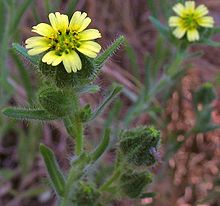Madia gracilis
| Madia gracilis | |
|---|---|

| |
| Scientific classification | |
| Kingdom: | Plantae |
| Clade: | Tracheophytes |
| Clade: | Angiosperms |
| Clade: | Eudicots |
| Clade: | Asterids |
| Order: | Asterales |
| Family: | Asteraceae |
| Genus: | Madia |
| Species: | M. gracilis
|
| Binomial name | |
| Madia gracilis | |
Madia gracilis is a species of flowering plant in the aster family known by the common names grassy tarweed, slender tarweed, and gumweed madia.[1][2]
Distribution[]
The annual herb is native to western North America: from British Columbia, through California to Baja California; and east to Utah and Montana.[3][4] It grows in many habitat types except for arid desert areas, including oak woodlands and mixed evergreen forests.[5]
Description[]
Madia gracilis is vstem is branching, and hairy and glandular in texture. The leaves are up to 10 centimeters long and covered in soft hairs and stalked resin glands.
The inflorescence is an array of clusters of flower heads. Each head is lined with phyllaries that are coated densely with stalked knobby resin glands. It bears yellow, lobe-tipped ray florets a few millimeters long and several black-anthered disc florets.
The fruit is a flat, hairless achene with no pappus.
Uses[]
The seeds were used to make pinole by the indigenous , Miwok, and Pomo peoples of California.[6]
References[]
- ^ ITIS Standard Report Page: Madia gracilis
- ^ Flora of North America
- ^ USDA: Madia gracilis
- ^ Encyclopedia of Life: Madia gracilis, C.Michael Hogan ed. 2010
- ^ Jepson Madia gracilis[permanent dead link]
- ^ University of Michigan at Dearborn: Native American Ethnobotany of Madia gracilis
External links[]
| Wikimedia Commons has media related to Madia gracilis. |
- Calflora Database: Madia gracilis (Gumweed madia, grassy tarweed, slender tarweed)
- USDA Plants Profile for Madia gracilis (grassy tarweed)
- Jepson Manual eFlora (TJM2) treatment of Madia gracilis[permanent dead link]
- UC Photos gallery — Madia gracilis
- Madia
- Flora of the Northwestern United States
- Flora of California
- Flora of Baja California
- Flora of British Columbia
- Flora of Nevada
- Flora of Utah
- Flora of the Cascade Range
- Flora of the Great Basin
- Flora of the Sierra Nevada (U.S.)
- Natural history of the California chaparral and woodlands
- Natural history of the California Coast Ranges
- Natural history of the Peninsular Ranges
- Natural history of the Transverse Ranges
- Plants used in Native American cuisine
- Asteroideae stubs